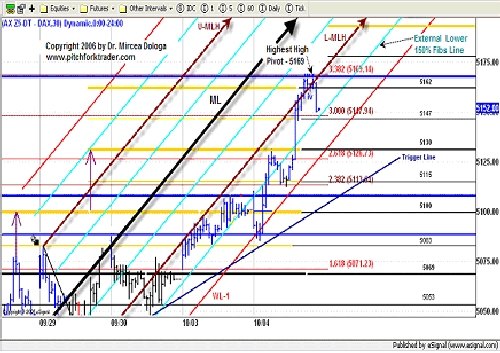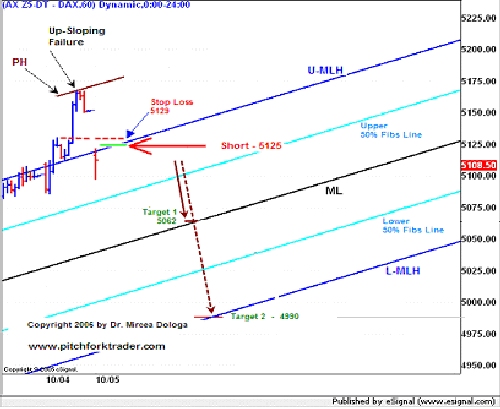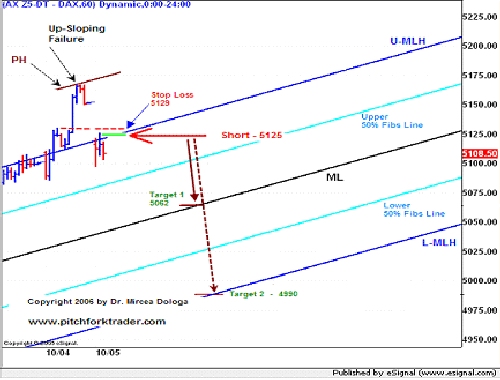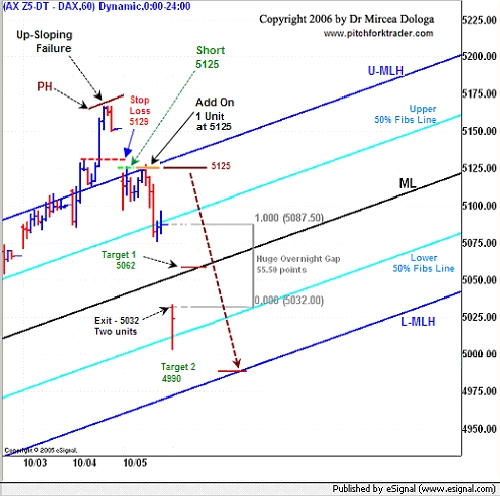In this article we look at preparation, techniques and money management for using integrated pitchfork analysis.
Spotting the Trade Opportunity
The process of low-risk high-probability spotting trades is very systematized for the experienced trader. He/she should visually scan the various choices of the operational time frame charts: 60-min, 30-min, 15-min and less frequently the 5-min chart. Our goal is to detect candidates representing low-risk high-probability trades. Once these opportunities revealed, we will employ different techniques with all the recommended disciplined rigour and patience. One of these is the zoom-and-retest technique, which is applied to a German Dax up-sloping failure.
Finding the Optimal Set-Up
In this trade, we have spotted triple up-sloping failures on 60-min, 30-min and 15-min operational charts (refer to Figures 1, 2 and 3). We have chosen the 60-min chart (refer to Figure 4), as our optimal operational trading time frame, because of the better trend visualisation, longer running profit and less market noise. The risk might be slightly higher but the profit, like I said, much more consistent.
Time Frame Alignment
We have noted that the upper time frames (weekly and daily charts) are both in the same up-sloping direction, but ready to be corrected. Then, we have looked at the three lower time frames (60-, 30- and 15-min) to observe the local market movements, and to better pinpoint our entry. We notice that the corrections of the three up-sloping trends, on theses charts have already started. The 5169 level pivot is common for all the studied time frames: weekly, daily (both charts not shown), 60-min, 30-min and 15-min charts

The above 60-min chart illustrates the beginning of a correction with a big down-bar, closing right on the Center Line of the Action/Reaction lines set-up. The triple mirror pattern at the highest high (5169 level) is the guarantor of the reversal, beginning of a correction. It is highly probable that the down move will continue, at least a few bars, with intense momentum.

The above 30-min chart illustrates the beginning of a correction. The market travelled for a 6-bar duration on the lower median line, through a very narrow ascending channel, being halted cold at the 5169 resistance level. Then, it dropped with a big down-bar; very close to the external lower 150% Fibonacci line. The triple mirror pattern at the highest high is the guarantor of the reversal, beginning of a significant correction. It is highly probable that the down move will continue, at least for a few bars, with high-steamed momentum.

The above 15-min chart illustrates the beginning of a correction. The very strong market travelled almost vertically, made an eight bar narrow range consolidation below the 5169 level. Then, it dropped with a big down-bar, almost freely. The triple top pattern at the highest high is the guarantor of the reversal, beginning of a significant correction. It is highly probable that the down move will continue, for at least a few bars, with the same vigorous momentum.
Three Pawn Technique - Triple Order Preparation and Trade Execution
By observing the Figure 4, we note that the down move continues strongly, as anticipated, and created a down-gap, zooming through the upper median line of the ascending pitchfork. Now that the zoom is accomplished, let us consider the following trade, in case of a test or retest of the upper median line (U-MLH):
Due to the size and the location of the gap, which is probably a breakout gap, it seems that the trade has a high probability potential. Thus, we will consider, two trading units:
But before placing any orders, we will have to establish the reward/risk ratio, and verify if the R/R ratio value is above/below our 2.5 usual limit.

Let us proceed and calculate the reward/risk ratio (R/R ratio), for this low-risk high-probability short trade. The calculation per contract will be only done until the target n°1. For the target n°2 there will be no risk because as soon as the target n°1 is attained, we will move the stop loss to the break-even point at 5125 level:
Conclusion - the R/R ratio being excellent, we will place our three pre-arranged orders.

The second bar of the opening just retraced, slightly over the upper median line, thus executing the entry order (Figure n° 5). The third opening bar (last one on the chart) has its close in its lower quarter, hinting towards a down-sloping move. We are confident in our progressing short-trade, mainly because of the breakout gap and the down-zooming huge bar.

The market has started to develop a pullback with regard to the down-move (refer to Figure 6). It is an excellent opportunity to add on (scale in) one trading unit. When adding, the trader should add on fewer units than the number of initial entry units. The standard value is 33% to a maximum of 50% of the number of the total entry units.
Therefore, we enter a pre-arranged add on unit sell stop order at 5125 level. The same stop loss (5129 level ) will be used, as that of the initial entry, targeting the same target n°1.
Therefore, we will have two trading units initially entered and a third one, as an add on, a total of three units. Two are exiting at target n°1 level, and the third at target n° 2 level. The enormous potential of this trade requires more than an intra-day trading session, so we have decided to let the trade in overnight.

As anticipated, the next day, the market dropped farther (refer to Figure 7) with a huge gap of 55.5 Dax points. Not only did the market price reach our target n° 1, but it exceeded it. At the opening of next day, we were still in the trade, in spite of the pre-arranged buy stop at 5062 (target n° 1). Thus, we had to manually exit with two units, right at the opening bar (5032 level). We also moved the stop of the remaining trading unit to the break-even level. We note that the occurrence of a second gap, usually called the running gap, gives another dimension to the already consistent trade potential.
The 50% level of the latter gap represents the half potential of the entire trend. The opening bar of the next day (refer to Figure 7) has a huge down tail, representing two thirds of the body. It only signals a short break in the strong down market drop. It looks like the target n°2 has a great probability to be attained. This would be the moment to add on (scale in) another trading unit, because of the high probability trade outcome.

The above chart illustrates the targeting out of our last unit (the third one) at 4990 level (target n°2) during the last hour of the day. Thus, our trade was terminated. We should emphasize here, the merit of the pre-arranged exits, especially the second one, which helped us to get the most out of this trade. Without this, we would have not been able to optimally manage the trade.
Profit & Loss - P/L Statement
Now, that the trade has been concluded let us see its outcome:
Therefore, we have obtained the following results:
The total financial result per contract (all three units) is 321 Dax points (2x93 + 1x135) a total of 8025 euros ($10191). The total time spent in the trade was two days, from the second hourly bar of the first day to the last bar of the next day.
Trader's Journal - Keep Your Records
We write in the journal the main topics and also the unusual events or missing opportunities due to either the respect of the rules, or to the occurrence of new lessons pertaining to the learning curve.
Let us proceed further:
Spotting the Trade Opportunity
The process of low-risk high-probability spotting trades is very systematized for the experienced trader. He/she should visually scan the various choices of the operational time frame charts: 60-min, 30-min, 15-min and less frequently the 5-min chart. Our goal is to detect candidates representing low-risk high-probability trades. Once these opportunities revealed, we will employ different techniques with all the recommended disciplined rigour and patience. One of these is the zoom-and-retest technique, which is applied to a German Dax up-sloping failure.
Finding the Optimal Set-Up
In this trade, we have spotted triple up-sloping failures on 60-min, 30-min and 15-min operational charts (refer to Figures 1, 2 and 3). We have chosen the 60-min chart (refer to Figure 4), as our optimal operational trading time frame, because of the better trend visualisation, longer running profit and less market noise. The risk might be slightly higher but the profit, like I said, much more consistent.
Time Frame Alignment
We have noted that the upper time frames (weekly and daily charts) are both in the same up-sloping direction, but ready to be corrected. Then, we have looked at the three lower time frames (60-, 30- and 15-min) to observe the local market movements, and to better pinpoint our entry. We notice that the corrections of the three up-sloping trends, on theses charts have already started. The 5169 level pivot is common for all the studied time frames: weekly, daily (both charts not shown), 60-min, 30-min and 15-min charts

The above 60-min chart illustrates the beginning of a correction with a big down-bar, closing right on the Center Line of the Action/Reaction lines set-up. The triple mirror pattern at the highest high (5169 level) is the guarantor of the reversal, beginning of a correction. It is highly probable that the down move will continue, at least a few bars, with intense momentum.

The above 30-min chart illustrates the beginning of a correction. The market travelled for a 6-bar duration on the lower median line, through a very narrow ascending channel, being halted cold at the 5169 resistance level. Then, it dropped with a big down-bar; very close to the external lower 150% Fibonacci line. The triple mirror pattern at the highest high is the guarantor of the reversal, beginning of a significant correction. It is highly probable that the down move will continue, at least for a few bars, with high-steamed momentum.

The above 15-min chart illustrates the beginning of a correction. The very strong market travelled almost vertically, made an eight bar narrow range consolidation below the 5169 level. Then, it dropped with a big down-bar, almost freely. The triple top pattern at the highest high is the guarantor of the reversal, beginning of a significant correction. It is highly probable that the down move will continue, for at least a few bars, with the same vigorous momentum.
Three Pawn Technique - Triple Order Preparation and Trade Execution
By observing the Figure 4, we note that the down move continues strongly, as anticipated, and created a down-gap, zooming through the upper median line of the ascending pitchfork. Now that the zoom is accomplished, let us consider the following trade, in case of a test or retest of the upper median line (U-MLH):
- Sell stop entry at 5125 - if test or retest, after zooming move,
- Initial stop loss - buy stop at 5129 - just above the last high of the previous trend,
- First profit target objective (target No 1) - buy stop at 5062 - at the confluence of the market price with the median line (ML).
- Second profit target objective (target No 2) - buy stop at 4990 - at the intersection of the market price with the lower median line (L-MLH). The value of this target has been calculated using the ATRs technique.
Due to the size and the location of the gap, which is probably a breakout gap, it seems that the trade has a high probability potential. Thus, we will consider, two trading units:
- First that will be exited at the target No 1 level, and
- The second that will be exited at the target No 2 level. Who knows, we might be able to get a free ride and trade with the market's own money.
But before placing any orders, we will have to establish the reward/risk ratio, and verify if the R/R ratio value is above/below our 2.5 usual limit.

Let us proceed and calculate the reward/risk ratio (R/R ratio), for this low-risk high-probability short trade. The calculation per contract will be only done until the target n°1. For the target n°2 there will be no risk because as soon as the target n°1 is attained, we will move the stop loss to the break-even point at 5125 level:
- Reward is 63 Dax points for target No 1, [entry level (5125) minus target n°1 level (5062)],
- Risk is 4 Dax points - [stop loss level (5129) minus entry level (5125)],
- Reward/Risk ratio is 15.75 - (63 divided by 4) - an excellent value.
Conclusion - the R/R ratio being excellent, we will place our three pre-arranged orders.

The second bar of the opening just retraced, slightly over the upper median line, thus executing the entry order (Figure n° 5). The third opening bar (last one on the chart) has its close in its lower quarter, hinting towards a down-sloping move. We are confident in our progressing short-trade, mainly because of the breakout gap and the down-zooming huge bar.

The market has started to develop a pullback with regard to the down-move (refer to Figure 6). It is an excellent opportunity to add on (scale in) one trading unit. When adding, the trader should add on fewer units than the number of initial entry units. The standard value is 33% to a maximum of 50% of the number of the total entry units.
Therefore, we enter a pre-arranged add on unit sell stop order at 5125 level. The same stop loss (5129 level ) will be used, as that of the initial entry, targeting the same target n°1.
Therefore, we will have two trading units initially entered and a third one, as an add on, a total of three units. Two are exiting at target n°1 level, and the third at target n° 2 level. The enormous potential of this trade requires more than an intra-day trading session, so we have decided to let the trade in overnight.

As anticipated, the next day, the market dropped farther (refer to Figure 7) with a huge gap of 55.5 Dax points. Not only did the market price reach our target n° 1, but it exceeded it. At the opening of next day, we were still in the trade, in spite of the pre-arranged buy stop at 5062 (target n° 1). Thus, we had to manually exit with two units, right at the opening bar (5032 level). We also moved the stop of the remaining trading unit to the break-even level. We note that the occurrence of a second gap, usually called the running gap, gives another dimension to the already consistent trade potential.
The 50% level of the latter gap represents the half potential of the entire trend. The opening bar of the next day (refer to Figure 7) has a huge down tail, representing two thirds of the body. It only signals a short break in the strong down market drop. It looks like the target n°2 has a great probability to be attained. This would be the moment to add on (scale in) another trading unit, because of the high probability trade outcome.

The above chart illustrates the targeting out of our last unit (the third one) at 4990 level (target n°2) during the last hour of the day. Thus, our trade was terminated. We should emphasize here, the merit of the pre-arranged exits, especially the second one, which helped us to get the most out of this trade. Without this, we would have not been able to optimally manage the trade.
Profit & Loss - P/L Statement
Now, that the trade has been concluded let us see its outcome:
- We have taken three trading units, all of them traded following an automatic pilot mode with pre-arranged orders, even if the market forced us, to exit manually. We should emphasize that all three units were governed by the three-pawn technique.
- We have risked per contract four DAX points representing 100 euros ($127).
- The reward per contract pertaining to the R/R ratio of 15.75, initially calculated per contract, was 63 Dax points. As we know, we have traded three units: two at the initial entry and one add on. Their exits were as follows: two units at 5032 level, and the last one at 4990 level.
Therefore, we have obtained the following results:
- Firstly, for the two trading units, we have per contract a reward of 93 Dax points:
[entry level (5125) minus exit No 1 level (5032)],
- Secondly, for the third trading unit, we have per contract a reward of 135 Dax points:
[entry level (5125) minus exit No 2 level (4990)],
The total financial result per contract (all three units) is 321 Dax points (2x93 + 1x135) a total of 8025 euros ($10191). The total time spent in the trade was two days, from the second hourly bar of the first day to the last bar of the next day.
Trader's Journal - Keep Your Records
We write in the journal the main topics and also the unusual events or missing opportunities due to either the respect of the rules, or to the occurrence of new lessons pertaining to the learning curve.
Let us proceed further:
- We fully respected the rules, especially the three pawn technique rules.
- The trade reward is excellent, above the average results.
- We have comfortably detected the first add on opportunity which we traded and also the second one below 5032 level, right at the opening of the second bar of the second day. We chose not to trade the latter because of the large required stop loss.
- Once again, we realized the importance of identifying the types of gaps and their relationship with:
- The median line and its contextual pitchfork acolytes,
- Money management of the trade.
- The median line and its contextual pitchfork acolytes,
- We took note of the role of the scanning of all five times frames, in order to reveal a low-risk high-probability trade, thus giving us an increased confidence in our tools and techniques. This is one of the best remedies for treating and healing the trigger-shy syndrome.
- We noticed also the role of the failures, their detection and also the best way to trade them. Their concomitant occurrence in the already mentioned multiple times frames enhances, several times, the classic trade potential. Always look for them? they are great money-makers!
Last edited by a moderator:
